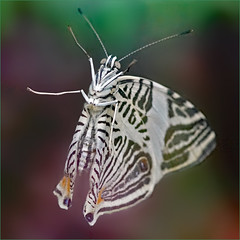.
In Explore, April 25 , 2024
The Dirce Beauty (Colobura dirce), also known as the Mosaic or Zebra Mosaic, is a butterfly of the Nymphalidae family.
The Mosaic is found in Central America and the northern parts of South America.
The wingspan is 60 - 70 mm. Often they are though encountered within shady forest sitting on tree trunks. They habitually settle in a head-downwards position, with wings held erect, while imbibing moisture from mosses or from tiny crevices in the bark.
De zebra- of mozaïekvlinder (Colobura Dirce) is een niet zo bekende vlinder uit de Nymphalidae familie, onderfamilie Nymphalinae. De soort komt voor in Midden-Amerika en noordelijk Zuid-Amerika tot een hoogte van 1600 meter boven zeeniveau. Het is een snelle vlieger.
De onderkant van de vleugels vormen een zebra-achtig patroon met een brede witte band langs de top van de voorvleugel. Aan de bovenzijde zijn de vleugels bruin met dezelfde brede witte band. De vlinders hebben opvallende oogjes op de staartjes. De vleugelspanwijdte is 60 à 70 mm.
Vaak worden ze aangetroffen in schaduwrijke bossen zittend op boomstammen met het kopje naar beneden en de vleugels rechtop gehouden, zoals ook op de foto hierboven, terwijl ze vocht van mossen of uit kleine spleten in de schors opnemen.
_________________________
All rights reserved. Copyright © Martien Uiterweerd. All my images are protected under international authors copyright laws and may not be downloaded, reproduced, copied, transmitted or manipulated without my written explicit permission.
_________________________
.
.



















